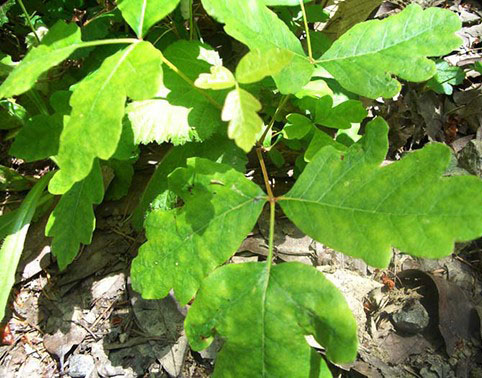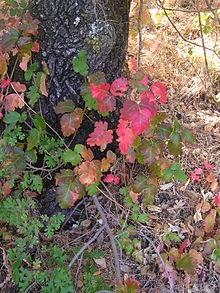We are very fortunate to live here in Southern California. The weather, as we all know, is phenomenal throughout the year. In Orange County we are also blessed with beautiful parks in which to enjoy this weather practically year round: Aliso and Wood Canyons Wilderness Park, Laguna Coast Wilderness, Irvine Regional Park. Limestone Canyon Regional Park, Whiting Ranch Wilderness Park, O’Neil Regional Park, Thomas Riley Wilderness Park, Ronald W. Caspers Wilderness Park, and the Cleveland National Forest where Santiago Peak is a popular destination. All these areas feature the wild side of Orange County and the opportunity to explore wilderness via hiking and mountain biking trails. Besides the natural beauty, what do all these wild places have in common………POISON OAK.
Poison oak belongs to the Anacardiaceae family of plants, which cause the majority of cases of allergenic contact dermatitis. The important plants in this group are poison ivy, western poison oak, eastern poison oak and poison sumac. Here in Orange County, if you develop a plant related contact dermatitis, it’s due to western poison oak. Poison Ivy does not grow in California. Eastern poison oak grows, well, in the east and poison sumac grows in swamps. Regardless of which plant you come in contact with, it’s the chemical urushiol, which is common to all these poisonous plants that causes the allergic skin reaction.
Most people have sensitivity to urushiol and will develop a pruritic (itchy) rash as a result. In the U.S., 25-40 million people yearly require medical care for exposure to poison oak, ivy or sumac. Forest workers, firefighters and farm workers form the bulk of the cases due to exposure to these plants while working. Poison oak dermatitis affects all skin types and ethnicities. Children over the age of 8 are typically sensitized. The allergic reaction can diminish with age especially if there has been limited exposure to the plant or in those who developed only a mild allergic reaction when exposed.
Urushiol is the main component found in the plant oleoresin, which is the colorless oil found in the leaves, fruit, stem and roots of the plant. Coming in contact with a bruised or broken plant parts allows the oil to be transferred to the skin, clothing, pets, tools, fingernails or other objects. An intact plant does not cause dermatitis but the plants are easily damaged by the rain or dry hot weather; brushing or rubbing against it, falling into it or inadvertently walking through it.
Once exposed, a sensitized individual will develop the classic dermatitis in 4-96 hours. There is intense itching and redness of the exposed skin. The areas usually become raised patches with fluid filled blisters. Involvement of the face or genital areas can cause significant swelling of the skin. Symptoms peak anywhere from 1-14 days after exposure. New lesions can appear up to 21 days after exposure in those not previously exposed. Re-exposure to the resin from pets, fingernails or tools/equipment can prolong the dermatitis and put contacts at risk for developing dermatitis as well. Left untreated, the rash usually resolves in about 1-3 weeks. Sometimes a secondary bacterial infection can develop.
The diagnosis of contact dermatitis due to poison oak is based on exposure to the plant or an area known to harbor the plant with the characteristic rash. Other causes for contact dermatitis are nickel or other metals, skin irritants, dermatitis due to sun exposure or other cross reactive poisonous plants.
Treatment for allergenic contact dermatitis due to plants focuses on relieving the intense itching associated with the rash. There is very little controlled clinical trial data to reference in treating poison oak dermatitis and most therapies are based on anecdotal experience among clinicians.
- Topical therapy such as oatmeal baths, cool, wet compresses or over-the-counter remedies containing menthol and phenol (calamine) can provide some temporary relief. Topical antihistamines, anesthetics or antibiotics are NOT RECOMMENDED due to their own allergenic properties.
- Sedating oral antihistamines like Benadryl (diphenhydramine) or Atarax (hydroxyzine) are helpful with pruritus primarily due to their sedating effects.
- High potency prescription topical corticosteroids (steroids) are helpful early in the course of the rash but should not be used on the face, genitals or in the creases of the groin area.
- Oral corticosteroids are helpful in patients with severe dermatitis especially if it involves the face or genitals. The data is limited on their use but anecdotal experience has established that at least a 14-day course is required to prevent rebound dermatitis, which occurs with shorter treatment courses.
- Antibiotics are appropriate if there is concern for secondary bacterial infection. Antibiotic selection should be based on coverage for typical skin bacteria like Staph and Strep. Cultures of the rash or areas of infection are always indicated prior to starting antibiotic treatment.
Prevention of poison oak dermatitis requires avoidance of the plant when outdoors, protection from the sap and post exposure measures. The old Boy Scout saying of “leaves of three, leave them be” holds true for identifying the plant but the appearance may vary based on the season.
Poison oak in the spring
Poison oak in the fall
Wearing protective clothing can be helpful but the sap can seep though most material to reach the skin. It is also important to remember that the oleoresin can remain on clothes, pets and under fingernails for several days after contact. Removal of clothing and gentle washing of any exposed areas with warm soapy water as quickly as possible after exposure can limit the severity of the dermatitis. Cleaning under the fingernails will help to remove a possible reservoir of the oleoresin. Washing any clothing or tools that may have come in contact with the oleoresin are important measures to preventing secondary exposure. Vigorous scrubbing of exposed areas is not helpful and can worsen the dermatitis as well as washing exposed areas after the rash has developed.
There is a wild side to southern California especially here in Orange County where numerous wilderness parks and a National forest are located. The poison oak plant is commonly found in these rural, natural areas. When workers, hikers or bikers come in contact with poison oak they typically develop a very uncomfortable allergenic contact dermatitis from the plant oleoresin. By recognizing the plant in order to avoid it, wearing protective clothing and washing up immediately after a possible exposure one can limit the occurrence and severity of developing the associated itchy rash. If you unfortunately develop the associated dermatitis, local measures (oatmeal bath, calamine lotion) applied to the skin can be soothing. Taking oral, sedating antihistamines (Benadryl, Atarax) can ease the intense itching. Super potent topical steroids can decrease the severity and duration of the rash but cannot be used on the face or genitals. In severe cases or when the face or genitals are involved, oral steroids can also decrease the duration and severity of the rash but must be given for a minimum of 14 days to avoid rebound dermatitis. So when you are tromping or pedaling in the local woods, remain aware of poison oak. If you develop an itchy rash afterwards don’t hesitate to visit a doctor for an evaluation and explanation of your treatment options.
The information provided is for general interest only and should not be misconstrued as a diagnosis, prognosis or treatment recommendation. This information does not in any way constitute the practice of medicine, or any other health care profession. Readers are directed to consult their health care provider regarding their specific health situation. Marque Medical is not liable for any action taken by a reader based upon this information.




